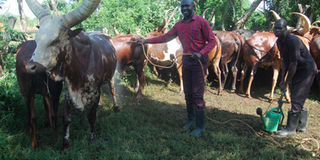Ankole breed turns Ogwang’s fortunes

Ogwang sprays his cattle against ticks. The farmer picks more than 100 litres of milk per day. PHOTO by Isaac Otwii
What you need to know:
A bull at Ogwang’s farm goes between Shs2m and Shs3m depending on the size. A litre of milk is sold at Shs600 and his farm earns him at least 120 litres a day depending on the number of calves, writes Isaac Otwii
Dressed in maroon trousers, a red long sleeve shirt, and black gumboots, Patrick Ogwang Obia walks in his livestock farm sitting on a two-acre land in Goi Village, Atong-tidi Sub-county, Kwania District while scouting ticks on his animals.
It has become Ogwang’s routine to check on his farm every morning. Ogwang who is also the LC3 chairperson of Chawente Sub-county believes that every successful business venture requires networking and consultations.
After serving as an office attendant in the office of the LC3 chairperson of Chawente Sub-county in the then Apac District in the early 1990’s, Ogwang opted to venture into livestock farming that is paying him off.
“During my employment as an office attendant my monthly pay was Shs69,000, but I lied to my wife that I was only receiving a payment of Shs29, 000 to enable me to save Shs40,000 at Cooperative Bank Apac. I eventually saved Shs180,000 that helped me start a small shop in Goi Landing site in Lake Kwania,” Ogwang said.
Starting
Ogwang recalls the challenges he faced. His shop operation turned to be a stepping stone towards his livestock investment.
He started in 2008 with only four indigenous breed of cattle locally called ‘dyang Lango’ that cost him Shs150,000 each.
“I spent Shs180,000 to fence the kraal, Shs120,000 was spent on insecticides while Shs100,000 went on labour,” he says.
Whilst using the money he generated from his shop for buying more cattle, in just five years the kraal had multiplied to 102 herds.
Through wide consultations and networking with Ankole cattle keepers, Ogwang sold off his indigenous cattle breed in 2013 and raised Shs46m. “I used the money to buy 41 Ankole cattle,” Ogwang said, adding “I was earning little profit and that is what forced me to change to Ankole cattle breed where I am earning better.”
According to Ogwang, an indigenous cattle goes between Shs400,000 and Shs600,000 after a period of between four to six years compared to Ankole cattle that costs between Shs1.9m and Shs2m in just two years. Currently, Ogwang has 192 Ankole breed on his farm.
Employees
Ogwang has employed two workers who are tasked with grazing the cattle in a free ranged system. Sometimes he uses the local community surrounding Goi Landing site to help him with exceptional farm activities.
Market
When faced with dry seasons, Ogwang says livestock farmers do better compared to crop growers; he sells his livestock to livestock dealers who transport to Arua District and South Sudan in large quantities.
A bull at Ogwang’s farm costs between Shs2m and Shs3m depending on the size.
A litre of milk is sold at Shs600 and his farm earns him at least 120 litres a day depending on the number of calves.
Accordingly, Ogwang gets Shs72,000 daily from milk sales. His main customers are community members.
Profit
He earns a profit of Shs20m after every annual sale of livestock which he uses for expanding his farm. “When a bull with mature weight mates, the effect is stillbirth and death of heifers, this is what happens at our farm prompting us to sell the mature weight bulls annually. But this has however helped me to expand the size of my livestock farm,” he said.
Increased knowledge
Ogwang consults his two farm doctors who visit the farm. He also visits progressive livestock farmers in the districts of Mbale, Mbarara, and Masaka.
“When I joined active politics in 2007, I chanced to visit President Museveni’s farm in his country home Rwakitura. From there, I learnt the importance of insemination,” he says. He also uses the Internet to get more knowledge on how to manage his livestock farm.
Farm record
Ogwang records the money he spends on insecticides and other expenditures. He also records the day each heifer is born.
Recording the birthday helps him identify the specific period a cow should be mated to reduce cases of stillbirth and death of cows at the farm.
Skills
Ogwang has constructed a kraal where his calves sleep; this enables his calves to grow faster.
“Many livestock farmers do not bother to build kraals and feed the calves. They believe that calves feed on milk only, this affects milk production and growth and this explains why my farm is progressing,” Ogwang says.
He pays attention to his workers, listens and responds to their concerns in time which motivates them towards working for the farm progress.
Achievements
The money generated from his farm helped him establish a school, ‘Obia Memorial Nursery and Primary School’ in Kwania District.
He also used the money from his livestock farm to buy a residential house in Aduku Township, paying his children’s tuition and procured two vehicles among other small investments.
Future plan
Ogwang plans to install an irrigation system to help him with his effort to use artificial grasses that ensure speedy growth of livestock and improves milk production in all seasons.
Challenges
Every success comes with a challenge. Though he is reaping well from livestock farming, he still encounters challenges including fluctuating prices of farm insecticides and planting grasses for dry season that consumes a lot of money thus reducing the profit he earns. “The farm doctor advised me to spray, inject and vaccinate the livestock after every fortnight. It is however tiresome when an outbreak occurs, especially foot and mouth disease which requires serious treatment,” Ogwang said.




